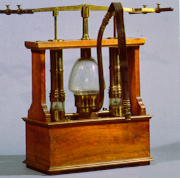
64 x 44 x 33
Wood, brass, glass and leather
CAT. 1824 : J.IV.99
Modelo d'uma bomba dos incendios.
Model of a fire pump.
This model of a fire pump constructed on the basis of a system described by Nollet in his Leçons de Physique Expérimentale, is basically composed of two vertical cylinders, inside each of which is a piston which can be moved. Each piston is connected by means of a joint to one of the arms of a lever which, when manipulated, effects a rising and falling movement in a vertical plane.
A circular tube leads from the bottom of each cylinder into a reservoir of water. There is a valve at the junction between the tube and the inside of the cylinder that opens when the piston is pulled upwards and closes when it descends. When the piston rises, the pressure inside the cylinder decreases, permitting the entry of water which rises through the tube, filling the cylinder. When the piston descends, the water admission control valve closes. Simultaneously, a second valve in the side of the cylinder and near to the base, opens and sends water through into a glass receptacle. The communication between the cylinder and this receptacle is made through a brass tube. This valve stays open during the descent of the piston inside the cylinder, thus transferring the water to the glass reservoir situated between the two cylinders.
Working simultaneously, the two cylinders operate in such a way that while one of them pushes water from the reservoir situated in the lower part of the pump, the other transfers the water inside it into the glass reservoir. A tube which is curved at the end leads out of the base of this reservoir, fitting into a leather hose, through which the water is expelled under pressure.
The system described above, mounted on a wooden structure, was used in lessons on the mechanics of fluids and constitutes a magnificent model of a pump which was used to combat fires over many years.
Nollet, Jean Antoine, Leçons de Physique Expérimentale, Paris, 1764, Vol. II, Lec. VII, Pl. 6, p. 255.